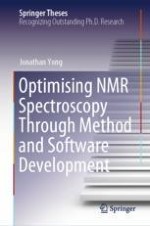This book provides a comprehensive overview of Nuclear Magnetic Resonance (NMR) theory, its applications, and advanced techniques to improve the quality and speed of NMR data acquisition. In this book, the author expands his outstanding Ph.D. thesis and provides a valuable resource for researchers, professionals, and students in the field of NMR spectroscopy.
The book covers quantum mechanics basics, and topics like density operators, pulse sequences, 1D pulse acquisition, INEPT (Insensitive nuclei enhancement by polarization transfer), product operators, and 2D NMR principles. It also explores innovative experiments like States HSQC (Heteronuclear Single Quantum Coherence) and echo-antiecho HSQC with gradients.
In the subsequent chapters, the author discusses Pure Shift NMR, including PSYCHE (Pure Shift Yielded by Chirp Excitation) and its optimizations, such as waveform parameterization and time-reversal methods. The 'Discrete PSYCHE' approach and Ultrafast PSYCHE-iDOSY (Diffusion-ordered spectroscopy) are also highlighted.
This book presents the POISE (Parameter Optimisation by Iterative Spectral Evaluation) software for real-time NMR experiment optimization, including pulse width calibration and Ernst angle optimization, and demonstrates applications across various NMR experiments.
Lastly, the book examines accelerated 2D NMR data collection and the NOAH (NMR by Ordered Acquisition using 1H detection) supersequences, emphasizing automated pulse program creation using GENESIS (GENEration of Supersequences In Silico). Covered NMR experiments include 13C sensitivity-enhanced HSQC, 15N HMQC (Heteronuclear Multiple Quantum Coherence), dual HSQC, HSQC-TOCSY (Total Correlation Spectroscopy), HMBC (Heteronuclear Multiple Bond Correlation), and ADEQUATE (Adequate Sensitivity Double-Quantum Spectroscopy).
